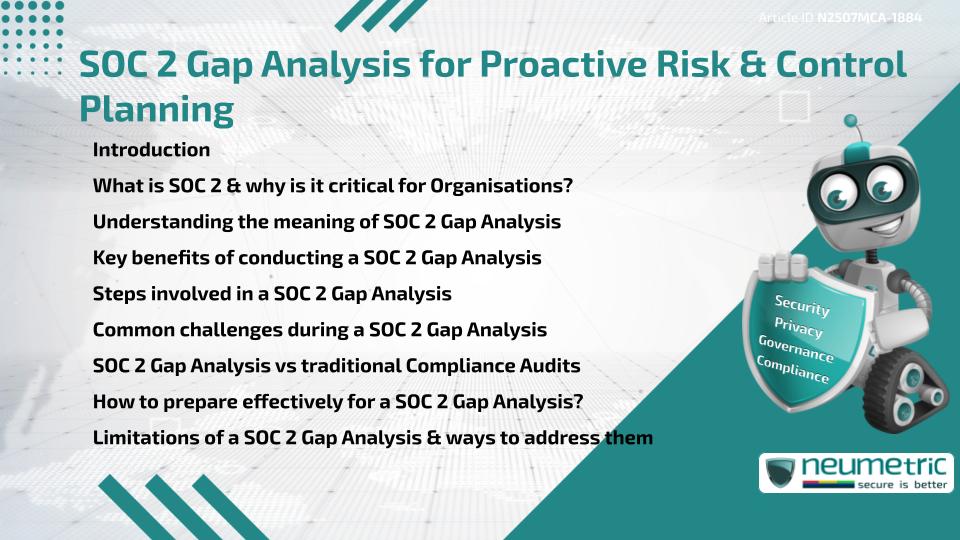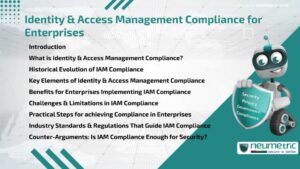Table of Contents
ToggleIntroduction
A SOC 2 Gap Analysis is a practical assessment that helps Organisations evaluate their existing systems & procedures against the rigorous standards of a System & organisation Controls 2 (SOC 2). This evaluation identifies gaps, weaknesses & areas that require improvement before undergoing a formal Audit. By proactively planning around these insights, Organisations can reduce Risk, strengthen control measures & ensure trust with Clients & Partners.
This article explores what a SOC 2 Gap Analysis entails, why it is essential for Organisations handling Sensitive Data & how it supports proactive Risk & control planning. We will also look into the key steps, challenges, limitations & differences between Gap Analysis & traditional audits.
What is SOC 2 & why is it critical for Organisations?
SOC 2 is a set of criteria developed by the American Institute of Certified Public Accountants (AICPA) focused on managing Customer Data based on five (5) Trust Services Criteria-Security, Availability, Processing Integrity, Confidentiality & Privacy.
Organisations that store or process Customer Information, especially in cloud-based environments, must ensure their controls align with these criteria. Failing to comply may lead to reputational damage, data breaches or lost business opportunities.
Unlike Certifications such as ISO 27001, SOC 2 reports are tailored to each Organisation’s systems & are often requested by customers, vendors or regulators to verify the strength of internal controls.
Understanding the meaning of SOC 2 Gap Analysis
A SOC 2 Gap Analysis is a self-evaluation process that allows an organisation to assess how its existing operational controls align with SOC 2 standards. It acts like a preliminary review or simulation to measure audit readiness before involving an independent auditor.
Rather than just pointing out missing documents or technical errors, the Gap Analysis focuses on the maturity, design & implementation of internal controls across all five (5) Trust Service Principles. This helps Organisations discover whether controls are sufficient, partially implemented or completely missing.
Conducting this analysis provides a clear snapshot of how well an organisation meets SOC 2 expectations & highlights what needs immediate attention.
Key benefits of conducting a SOC 2 Gap Analysis
Performing a SOC 2 Gap Analysis offers several practical benefits:
- Proactive Risk Identification: Organisations can identify Risks before they become compliance failures or Security Incidents.
- Strategic Resource Planning: It helps allocate people, tools & investments to address control weaknesses.
- Time Efficiency: Teams avoid delays during formal audits by resolving issues early.
- Increased Confidence: Internal Stakeholders & third parties gain assurance in your systems & readiness.
- Reduced Audit Costs: Well-prepared systems mean less remediation work during the actual Audit.
It is not just about passing an Audit-it is about building a culture of accountability & foresight in handling Sensitive Data.
Steps involved in a SOC 2 Gap Analysis
Here is a simplified breakdown of the SOC 2 Gap Analysis process:
- Define Scope & Trust Criteria
Identify which systems, departments & Trust Service Criteria apply to your Organisation. - Review Current Policies & Controls
Analyse how existing controls operate in real-time & how they are documented. - Map Controls to SOC 2 Requirements
Align your current controls with SOC 2 criteria to detect mismatches or deficiencies. - Conduct Interviews & Evidence Review
Speak with team leads, review logs & analyse policy implementation details. - Identify Gaps & Risk Areas
Highlight which areas fall short or lack documented proof of implementation. - Generate an Actionable Report
Summarise findings with prioritised recommendations & suggested timelines.
Each of these steps should involve collaboration between Compliance, IT & Operations teams to ensure a holistic review.
Common challenges during a SOC 2 Gap Analysis
While conducting a SOC 2 Gap Analysis offers value, it is not without its hurdles:
- Lack of Documentation: Many Organisations operate with informal or undocumented processes that are hard to assess.
- Misinterpretation of Criteria: Teams may misunderstand SOC 2’s intent, leading to inaccurate conclusions.
- Siloed Operations: Without cross-functional input, important Security practices may be overlooked.
- Limited Expertise: In-house teams may lack the experience to conduct a comprehensive evaluation.
Overcoming these challenges requires cross-team collaboration, skilled guidance & sometimes, external advisory support.
SOC 2 Gap Analysis vs traditional Compliance Audits
While both activities involve evaluating compliance with SOC 2, there are significant differences:
| Aspect | SOC 2 Gap Analysis | Traditional Audit |
| Timing | Pre-Audit Phase | Official Assessment |
| Purpose | Identify Readiness | Validate Compliance |
| Approach | Internal or Informal | External & Formal |
| Output | Action Plan | SOC 2 Type I or II Report |
| Flexibility | Custom & Iterative | Fixed in Structure |
You can think of a SOC 2 Gap Analysis like a trial run—it provides a chance to identify & correct weaknesses before the official evaluation begins.
How to prepare effectively for a SOC 2 Gap Analysis?
Organisations can boost the success of a Gap Analysis by:
- Establishing Clear Objectives
Decide whether the goal is Audit readiness, Risk reduction or system maturity. - Involving the Right People
Include IT, Legal, HR & Operations in the review process. - Using a Control Framework
Leverage frameworks like NIST Cybersecurity Framework to benchmark controls. - Maintaining Documented Evidence
Prepare access logs, policy records & system configurations for reference. - Reviewing Industry Resources
Stay updated using AICPA SOC Guidelines & Cloud Security Alliance.
These actions form a strong foundation for a complete & practical evaluation.
Limitations of a SOC 2 Gap Analysis & ways to address them
Although valuable, a SOC 2 Gap Analysis does come with certain drawbacks:
- No Formal Certification: It does not result in a SOC 2 Report or Audit letter.
- Subjective Evaluation: Outcomes depend on the experience & perspective of the assessor.
- Limited Assurance: Stakeholders may not accept it as evidence of compliance.
To mitigate these issues:
- Pair the Gap Analysis with Third Party reviews.
- Use standardised tools & scoring models.
- Treat it as an ongoing process rather than a one-time event.
Takeaways
- A SOC 2 Gap Analysis helps Organisations assess control readiness & manage Risk effectively.
- It serves as a practical, pre-Audit tool that reduces surprises during formal assessments.
- By engaging the right Stakeholders & following a structured process, Organisations can plan improvements with clarity.
- Despite its limitations, the Gap Analysis adds measurable value in compliance strategy & system maturity.
FAQ
What is the objective of a SOC 2 Gap Analysis?
The main purpose is to assess whether an organisation’s existing controls align with SOC 2 requirements before a formal Audit.
Is a SOC 2 Gap Analysis mandatory?
No, it is not mandatory but highly recommended to reduce Risk & prepare for a smoother Audit process.
Who should conduct a SOC 2 Gap Analysis?
It can be done internally by experienced Compliance professionals or with the help of Third Party Consultants.
How much time does a SOC 2 Gap Analysis take?
It typically takes between one (1) & four (4) weeks, depending on the size & complexity of the Organisation.
How frequently should a SOC 2 Gap Analysis be performed?
Ideally, it should be conducted annually or before major audits & system changes.
Does a SOC 2 Gap Analysis guarantee Audit success?
No, but it significantly improves readiness & reduces the chances of Audit failure.
Can Small Businesses perform a SOC 2 Gap Analysis?
Yes, Small Businesses can & should perform it to scale securely & gain Customer Trust.
Need help for Security, Privacy, Governance & VAPT?
Neumetric provides organisations the necessary help to achieve their Cybersecurity, Compliance, Governance, Privacy, Certifications & Pentesting needs.
Organisations & Businesses, specifically those which provide SaaS & AI Solutions in the Fintech, BFSI & other regulated sectors, usually need a Cybersecurity Partner for meeting & maintaining the ongoing Security & Privacy needs & requirements of their Enterprise Clients & Privacy conscious Customers.
SOC 2, ISO 27001, ISO 42001, NIST, HIPAA, HECVAT, EU GDPR are some of the Frameworks that are served by Fusion – a SaaS, multimodular, multitenant, centralised, automated, Cybersecurity & Compliance Management system.
Neumetric also provides Expert Services for technical security which covers VAPT for Web Applications, APIs, iOS & Android Mobile Apps, Security Testing for AWS & other Cloud Environments & Cloud Infrastructure & other similar scopes. Reach out to us by Email or filling out the Contact Form…





